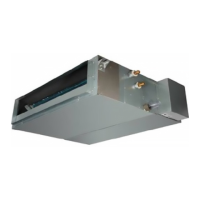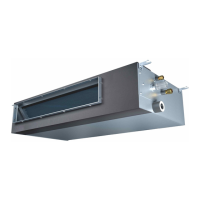
Do you have a question about the Hisense AUD-36HX6SAHH and is the answer not in the manual?
| Brand | Hisense |
|---|---|
| Model | AUD-36HX6SAHH |
| Category | Air Conditioner |
| Language | English |
Covers space saving, mute operation, self-recovery, fault diagnosis, static pressure, R410A, and timer functions.
Lists specific DC Inverter, On/Off Unitary, and High-Efficiency DC Inverter models.
Covers proper installation by qualified personnel and voltage checks.
Details hazards like product modification, flammable materials, and corrosive environments.
Addresses cord condition, earthing, wiring practices, and capacity checks.
Advises on reading the manual, intended use, and avoiding flammable gases.
Warns against using the main power switch, inserting objects, and extreme temperature settings.
Illustrates the physical components of indoor and outdoor units.
Presents images of wire and wireless remote controllers.
Details the functions and display of the wire remote controller.
Details the functions and display of the wireless remote controller.
Introduces the wired remote, its components, and basic functions.
Details ON/OFF, Mode selection, Fan speed, and Temperature setting.
Explains how to use the Timer and Sleep modes via the remote.
Details the various indicators, symbols, and displays on the remote's LCD screen.
Explains the meaning of icons related to mode, fan speed, timer, and operational status.
Details the procedure for choosing between Cooling, Dry, Fan, Heating, and Auto-run modes.
Explains how to set the desired temperature and fan speed using the remote.
Describes how to enable and disable the sleep function for a comfortable environment.
Explains the procedure to set a timer for the unit to automatically turn off.
Explains the procedure to set a timer for the unit to automatically turn on.
Provides step-by-step instructions for installing the wired remote controller.
Explains how the H1 remote transmits signals and its basic operation.
Details the purpose of each button on the H1 wireless remote.
Lists and explains the meaning of icons and indicators shown on the remote's LCD.
Guides on how to insert batteries correctly.
Explains how to use the remote controller to operate the air conditioner.
Explains how to cycle through Cooling, Dry, Fan Only, and Heating modes.
Details how to adjust fan speed in different modes.
Explains how to adjust the temperature setting.
Explains vertical and horizontal airflow adjustment using the remote.
Details how to control vertical louvers (swinging/fixed).
Details how to control horizontal louvers (swinging/fixed).
Explains how to use SMART mode and its automatic settings.
Details how to adjust fan speed and airflow direction within SMART mode.
Explains how to set the current time using the CLOCK button.
Explains how to set the timer to turn the unit on.
Explains how to cancel the Timer ON setting.
Describes the SLEEP mode and its automatic stop after 8 hours.
Explains the SUPER mode for fast cooling/heating.
Introduces the J1 wireless remote and its button functions.
Details the purpose of each button on the J1 wireless remote.
Introduces the E4-07 wireless remote and its button functions.
Details the purpose of each button on the E4-07 wireless remote.
Covers problems like not cooling/heating well and smells.
Explains sounds like deforming parts, steam, dew, and refrigerant flow.
Illustrates the refrigerant flow path.
Provides wiring diagrams for DC Inverter and On/Off Unitary types.
Lists crucial safety warnings for installation personnel and procedures.
Lists necessary tools for the installation process.
Covers initial checks and procedures for installing the indoor unit.
Details fixing suspension bolts, nuts, and ensuring the unit is level.
Notes on connecting ducts to the unit.
Specifies the type of pipe material and diameter for different models.
Details the process of connecting refrigerant pipes and tightening nuts with torque.
Explains the importance and method of insulating refrigerant pipes.
Guides on installing the drain piping correctly to prevent clogs and leaks.
Describes how to check for proper drainage using water.
Provides guidelines for checking electrical wiring connections and neatness.
Details connecting power cords, earth wires, and remote control wires.
Explains how to change the static pressure by adjusting fan motor terminals.
Lists static pressure settings for different models.
Lists recommended and avoided locations for outdoor unit installation.
Covers fixing the outdoor unit and connecting its wiring.
Details maximum tube length, height difference, and refrigerant addition.
Explains the process and characteristics of good flaring for copper tubes.
Guides on connecting refrigerant pipes, applying lubricant, and tightening connections.
Describes heat insulation and taping procedures for refrigerant tubes.
Details the steps for purging air and moisture using a vacuum pump.
Explains how to conduct a leak test on joints and valves.
Instructions for organizing and sealing tubes after installation.
Outlines checks and steps for the final operational test.
Covers electrical checks, stop valve operation, and safety warnings during running.
Provides guidelines on power source cable size, transmitting cable size, and wire selection.
Lists the items included with the indoor unit.
Lists the items included with the outdoor unit.
Provides guidance on the correct disposal of the product.











